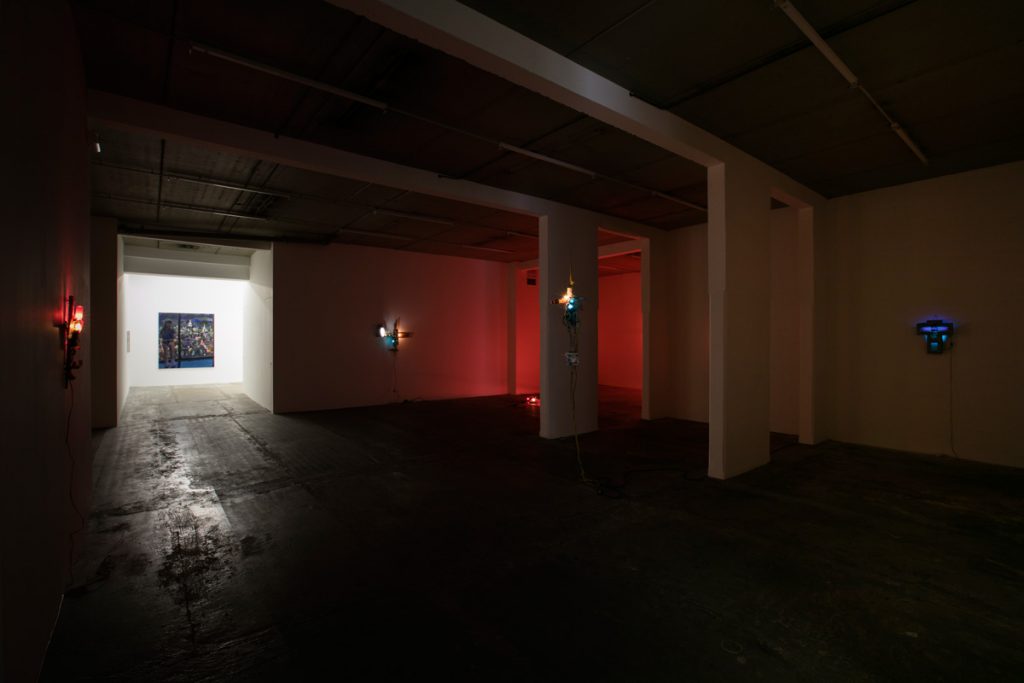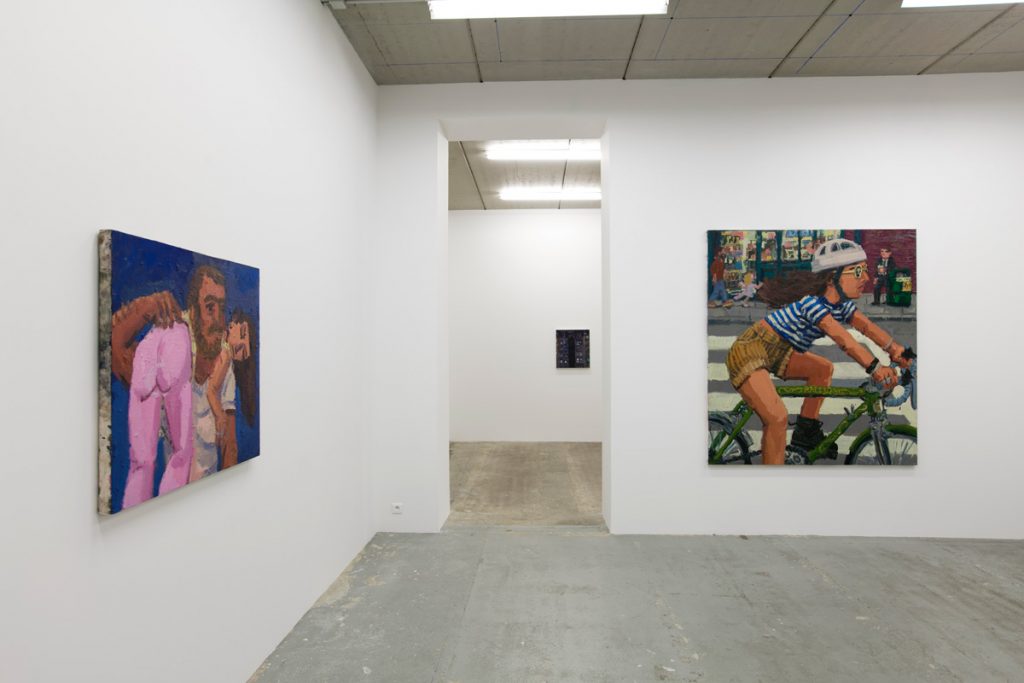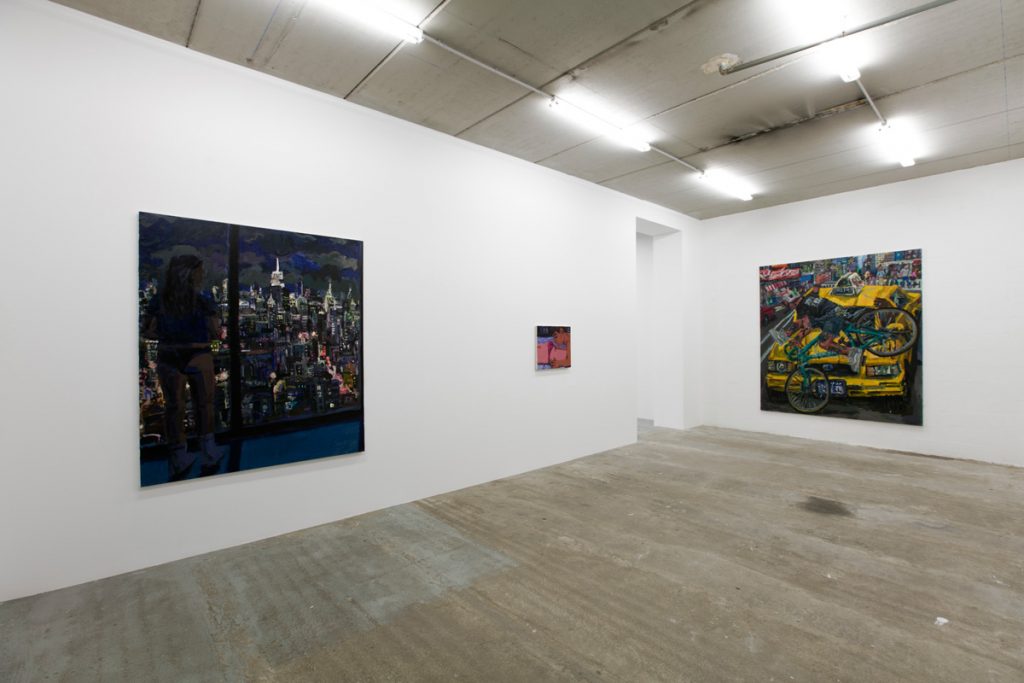ALAN VEGA,
Universe
TODD BIENVENU,
Jaywalk
June 23rd – July 28th, 2018 / Opening on Friday, June 22nd at 6:30 pm
THE LONG, HOT SUMMER
1956: Release of Elvis Presley’s first LP, Pollock’s real-fake suicide, in Tokyo, Tanaka Atsuko wears a dazzling
dress made of light bulbs and fluorescent tubes during one of Gutai’s first interventions, ”Lust for Life” hits
the screen, Minelli writes a flamboyant biography of Van Gogh that forever shapes the image of this artistic
genius in the collective mind. Alan Bermowitz is 18, an age that seems to count a bit more than the others.
Alan Vega, aka Alan Bermowitz, later said that the piles of bulbs and electric wires that revealed him to the art
world at the beginning of the 1970s was like the icebreaker of the New York school and that he forgot what it
brought to painting. It is true that his installations scattered on the floor are based on a bodily approach and
an organic look that entirely distinguishs them from the post-dada accumulations, and brings them closer to
the “eccentric abstraction”- coined by Lucy Lippard in reference to a specific post-minimal movement.
Later came: the cruciform objects –not to say the word “crucifix”– and various assemblings with found images
–to avoid the word icons– with a pronounced taste for boxing figures: a sort of mix between Peter Blake and
Ray Johnson. Vega was neither behind nor ahead of art history. Actually, he probably regarded it with some
indifference, as he started protesting with the art workers before even thinking about making a living. At
the biggest looser game he was truly unbeatable, fighting to keep the bond between being both brilliant and
broke.
Perfectly in tune with his time, and unlike the post-Dadaists who clung to the “beauty of indifference”, he
was moved by an excessive empathy that instilled the many stories behind his crosses and charms: from his
fascination for black boxers and their anger to the terror inspired by the marmoreal beauty of the Wehrmacht
soldiers. Titles like “Dachau”, a suburb of Munich, and “Buchenwald”, a suburb of Weimar, shows that Vega
also knew how to choose sides. This electric appropriation of beauties and tragedies with whatever was at
hand or in the street, bulbs in bulk traded for the gold of the Pop church or that of the minimalist temple, was
a bit like cheap mass Vega-style. Heaven and hell tangled and crossed since the crossroad of the blues also
shaped a spiritual road and that Vega’s assemblings might contain pieces of the true cross.
While the queens and kings of contemporary art made up stories and performances to back up their objects,
ut pictura praxis, Vega made sure that Suicide, the quintessence and greatest story behind (or before) his
art, overshadowed it. A duo that will forever embody the spirit and integrity of rock music -the devil’s song-
yet played without guitars or drums as if to say no to two-part rhythm. Punk was a story of resurrection and
fervor: the fervor we feel when listening to the laments in Frankie Teardrop or 96 Tears, which might have us
believe that this performing artist had the “gift of tears” spoken in the gospel. It was not before Felix Gon-
zalez-Torres that another artist used cheap lights to tell intimate tragedies and represent glorious bodies
next to a Eucharist in golden papers. Aren’t Alan Vega’s illuminations a secret link between Flavin and Gon-
zalez-Torres? His late drawings and paintings look like a strange come back to existentialist painting.
Star seems like the masterpiece of the series, announcing the shining disappearance of his avatar.
Todd Bienvenu’s painting repeatedly and explicitly quotes Max Beckmann, this modern medieval struck down
in the middle of Central Park on his way back from the Metropolitan to check the display of one of his self-por-
traits. As if he had found a kindred spirit to share his childmind and sense of grotesque with. In Bienvenu’s
teatrino where space and the canvas plane become one, tiny and thickly brushed characters interact with
merely sketched ghostly figurines, objects from his studio and street scenes usually seen on Instagram (Oh,
a biker! Oh, a nocturnal view of Manhattan!). His work praises our dreadful daily life all the while challenging
the codes of representation and the painter’s work, with a bit of allegorizing. For example, we see a com-
puter screen that reads REC while the couple staging appears as a mere super-flat black stain, faker than
the mirror reflections in a bar at Folies Bergères. This swiftness and edge only painting allows captures our
marvelous yet appalling era. And when Bienvenu wants to mock the deep reflections on computer-assisted
sexuality or over-ambitious and driven art, he goes straight to the point, which he sometimes likes to impaste
as if to highlight his craft. Another bacchanalia on the wall of the bar where his poor hero of the night is spit-
ting a monstrous green spurt, probably a blend of alcohol and liquor.
Behind his seeming indifference, Todd Bienvenu takes a lot of distance, starting with the American realism
from Hopper to Fischl, waving modernism for representing night owls and the X generation. Bienvenu’s po-
pular art depicts the little perversions of New York: an over-protected world that sometimes falls into excess
yet deprived of all tragic dimension or sense of drama. His work appears like a eulogy of freedom and im-
maturity: one does not paint a studio, a double portrait or a genre scene without being somehow part of the
comedy. To the lyrical masturbators of the New York school and the
Women of De Kooning, Bienvenu answers
with a giant carrying his prey, the object of his desire, reduced to a small thing wearing a tight jean or with a
soft kiss given to a single pink stain suggesting an ass: a perfect way to blow out desire and play tricks to the
good taste of painting. Unless it is the return of Ulysse-Leopold Bloom discovering Molly’s two hemispheres.
Childish and mocking, Bienvenu is free to the point of distancing himself from his Beckmann obsession whe-
never he pleases to dive into the expressionist fire (of Saint John), like a tapestry with interlocking and jux-
taposition. Furious and enraged in a minor mode, we might hear the screams of the little white man venturing
on the wild road like the Bavarian Kirchner.
From dark legend Vega and his wisely chosen nickname to Bienvenu, which alias shows off an everlasting
smile, the two artists share a talent of talking with the dead and picking heroes to delve in the meat of the
matter. For both of them, art is this suspension of incredulity that made Rauschenberg say: if you don’t take
this seriously, there’s nothing to take at all. And to think that something close to fascination can rouse from
a drunken evening and a pile of 1$ trinkets.
Patrick Javault




